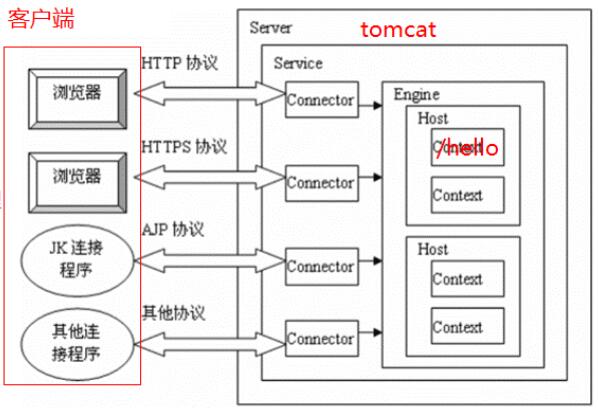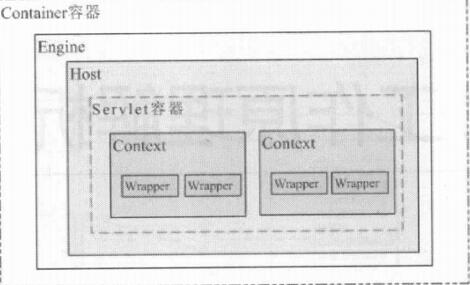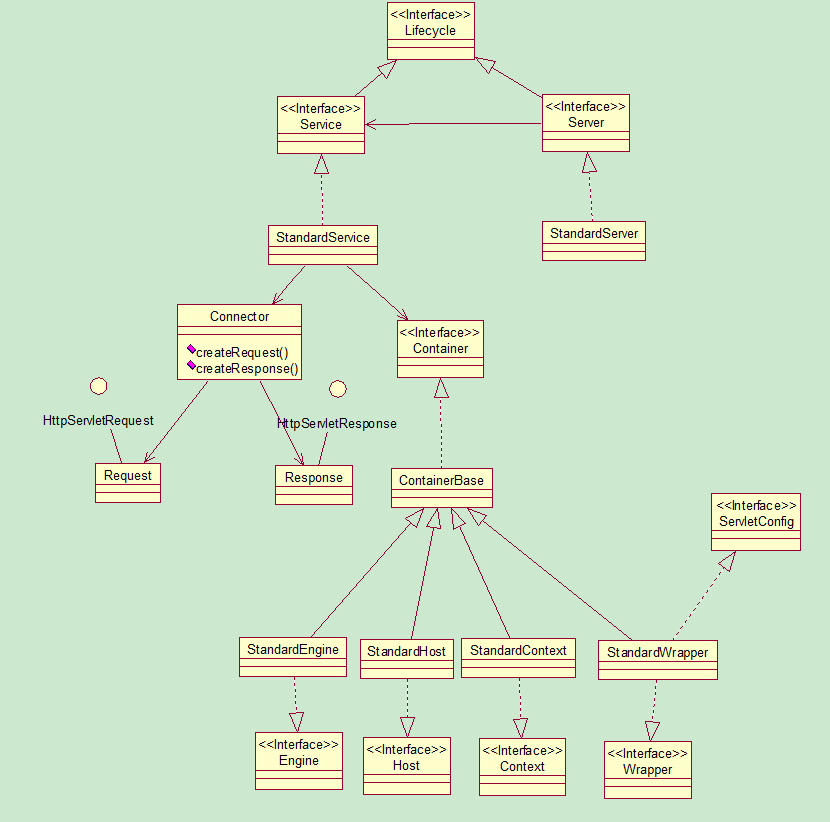深入理解Tomcat
Posted arctic_fox
tags:
篇首语:本文由小常识网(cha138.com)小编为大家整理,主要介绍了深入理解Tomcat相关的知识,希望对你有一定的参考价值。
简介
tomcat是一个web服务器,运行jsp和servlet,使用HTTP与客户端(通常是浏览器)进行通信。
构成
下图是tomcat的架构,可以看出:核心内容是Connector和Container组件。
一个Server服务器中可能有多个Service,Service可以暂时理解为“服务”。Server负责管理Service的生命周期,让外界能够访问。
Service将Connector和Container联系在一起了,类似“一纸婚约”,将一对夫妻结合,组成一个家庭。
下面就看一下核心内容部分吧
1、Connector
在学Java web基础的时候,提到过当从浏览器传过来http请求之后,web容器会创建一个request和response对象。在Tomcat中,负责该创建工作的是Connector组件。
Connector连接器可以有一个或多个,默认情况下会开启两个HTTP协议和AJP协议。
2、Container
先来看一下Container的详细结构图:
Container容器有四个子容器:Engine、Host、Context和Wrapper,他们之间是父子包含关系。
1)、Engine
2)、Host(虚拟主机)
3)、Context(所属的web应用上下文)
4)、Wrapper(针对的是每个具体的servlet,可以说他是最直接和servlet打交道的。)
可以看一下Tomcat的server.xml文件,来深入了解各组件之间的关系。
<?xml version="1.0" encoding="UTF-8"?>
<!--Server-->
<Server port="8005" shutdown="SHUTDOWN">
<Service name="Catalina">
<!-- A "Connector" represents an endpoint by which requests are received
and responses are returned. Documentation at :
Java HTTP Connector: /docs/config/http.html (blocking & non-blocking)
Java AJP Connector: /docs/config/ajp.html
APR (HTTP/AJP) Connector: /docs/apr.html
Define a non-SSL HTTP/1.1 Connector on port 8080
-->
<Connector URIEncoding="GB18030" connectionTimeout="20000" port="8080" protocol="HTTP/1.1" redirectPort="8443"/>
<!-- A "Connector" using the shared thread pool-->
<!--
<Connector executor="tomcatThreadPool"
port="8080" protocol="HTTP/1.1"
connectionTimeout="20000"
redirectPort="8443" />
-->
<!-- Define a SSL HTTP/1.1 Connector on port 8443
This connector uses the JSSE configuration, when using APR, the
connector should be using the OpenSSL style configuration
described in the APR documentation -->
<!--
<Connector port="8443" protocol="HTTP/1.1" SSLEnabled="true"
maxThreads="150" scheme="https" secure="true"
clientAuth="false" sslProtocol="TLS" />
-->
<!-- Define an AJP 1.3 Connector on port 8009 -->
<Connector port="8009" protocol="AJP/1.3" redirectPort="8443"/>
<!-- An Engine represents the entry point (within Catalina) that processes
every request. The Engine implementation for Tomcat stand alone
analyzes the HTTP headers included with the request, and passes them
on to the appropriate Host (virtual host).
Documentation at /docs/config/engine.html -->
<Engine defaultHost="localhost" name="Catalina">
<Host appBase="webapps" autoDeploy="true" name="localhost" unpackWARs="true">
<!-- Access log processes all example.
Documentation at: /docs/config/valve.html
Note: The pattern used is equivalent to using pattern="common" -->
<Valve className="org.apache.catalina.valves.AccessLogValve" directory="logs" pattern="%h %l %u %t "%r" %s %b" prefix="localhost_access_log." suffix=".txt"/>
<Context docBase="shop" path="/shop" reloadable="true" source="org.eclipse.jst.jee.server:shop"/></Host>
</Engine>
</Service>
</Server>- 1
- 2
- 3
- 4
- 5
- 6
- 7
- 8
- 9
- 10
- 11
- 12
- 13
- 14
- 15
- 16
- 17
- 18
- 19
- 20
- 21
- 22
- 23
- 24
- 25
- 26
- 27
- 28
- 29
- 30
- 31
- 32
- 33
- 34
- 35
- 36
- 37
- 38
- 39
- 40
- 41
- 42
- 43
- 44
- 45
- 46
- 47
- 48
- 49
- 50
- 51
- 52
- 53
- 54
设计思想
1)职责链模式
设计Container时使用到了职责链模式,我们可以明显的看到,Engine、host、context和Wrapper连接成一个链。当请求到来时,通过该链传递,最终到达处理请求的子容器。大话中的例子是“请假审批”,员工请假流程是一层一层进行的,如果经理可以审批,就不再继续走流程。如果经理无权力审批,就往上一层总经理传送,总经理可以审批就审批,不可以审批,请求就继续走下去,直到有人处理或请求被撤销。
多个对象有机会处理请求,发出请求和处理请求两者之间耦合关系减弱。对象连成一条链,沿着该链传递请求,直到有对象处理它为止。
2)命令模式
在设计Connector和Container关系时用到了命令模式。
Tomcat中可以有多个Connector,多个Connector和一个Container来构成了一个Service。Connector是请求者,而Container是接受命令并且执行的人。类似大话设计模式中,顾客点餐成烤串的例子。
将请求封装成一个对象,我们可以用参数封装各种请求,并且进行请求排队完成及时撤销等功能。
3)观察者模式
这个模式是比较常用的了,含义也就不用多说了,经常被用来实现“异步处理”。在Tomcat中有很多地方都用到了该模式,比如:Servlet实力的创建、Session管理、Lifecycle等。
观察者模式,也叫事件监听机制,也叫发布-订阅模式。想到什么?JMS的实现异步消息处理的Pub-Sub消息模型,还有NIO中将多个Channel注册到selector中监听消息等等等等。
大话中的例子是“老板回来,我不知道”。
以上是关于深入理解Tomcat的主要内容,如果未能解决你的问题,请参考以下文章



